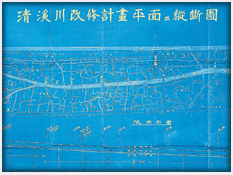|
|


| |
|
During the Japanese colonial period, the Cheonggyecheon went through some changes different from those made in the past. First of all, it came to get called "Cheonggye" as it is called today, supposedly from 1914, when the colonialists rearranged stream names in Korea.
In the past five centuries during the Joseon Dynasty, it was just called "Gaecheon (meaning a stream)." Looking at the newspapers published during that time, the name "Gaecheon" rarely appeared from about 1916, apparently giving its way to the "Cheonggyecheon."
|
|
The stream used to be the border between Bukchon and Namchon of the capital during the Joseon Dynasty. During the Japanese colonial period, the stream came to act as the border between Jongno regarded as the street for Koreans and Honmachi (referring to present Chungmuro), a Japanese town. The Japanese colonialists nicknamed the stream Dirty Stream by derision, instead of Cheonggyecheon (literally meaning a "Clean Stream").
|
From around 1918, the colonialists started overhauling the stream in connection with their plan to establish the central institutions to rule the colony, including Joseon Government-General, north of the stream.
In the post-1920s period, the colonialists announced their plans to cover up the stream on several occasions, including one announced in 1926 to form a 10,000-pyeong (= 8 acre) housing site, one announced in 1935 to build up a road and an elevated railroad, one announced in 1939 regarding exclusively cars, and one announced in 1940 to build up a streetcar path along with a subway. Such plans were intended to solidify the colonial rule over Korea and develop Seoul as a supply base for the wars that the colonialists were waging against the U.S.
and China, including the Pacific War.
|
|
However, with the exception of the Taepyeongno-Mugyodong section, which had been covered up in 1937, all those plans could never come true due to the lack of financial resources. The work for overhauling the stream caused many changes to the structures though. Due to the installation of a streetcar path nearby, Gwangtonggyo(Bridge) had been reinforced and expanded.
Next to the abutment of the bridge, sewage pipes exceeding 1 meter in diameter were buried. In 1908, Ogansumun, a landmark penstock, was completely dismantled to give its way to a bridge and a street. Several bridges, including Haranggyo and Yeongdogyo, were rebuilt.
|

|
|
|
|
|
|
|
|






